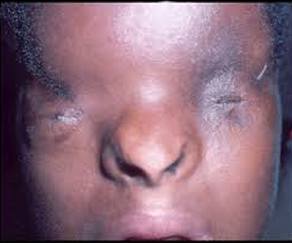

MedFriendly®


Ablepharia
Ablepharia is a condition present from birth in which
the baby is born with a partial or total absence of the
eyelids. This is a very rare condition. It usually occurs
in one eye but it can occur in both. When present,
there are usually other abnormalities of the eyes
present and there can be other abnormalities
throughout the body, as in Fraser syndrome. Fraser
syndrome is a genetic disorder that causes ablepharia
and genital malformation, along with other possible
abnormalities.
FEATURED BOOK: Encyclopedia of Genetic Disorders and Birth Defects
People with ablepharia appear to have no eyes since what would have been the eyelids
essentially fuse together. Tiny horizontal slits may be observed, however. The cornea
(the clear covering at the front of the eyeball) is replaced with a covering or hard tissue.
In ablepharia, the choroid and retina may be present or severely disorganized. The
choroid is a layer in the eye between the sclera (the outer, white part of the eye) and the
retina. The retina is an area at the back of the eye that is sensitive to light. Ablepharia is
also known as ablepharon, cryptophthalmos, and cryptophthalmia.
Ablepharia comes from the Latin word "a" meaning "without," and the Greek word
"blepharon" meaning "eyelid." Put the words together and you have "without eyelid."
"Where Medical Information is Easy to Understand"™
















